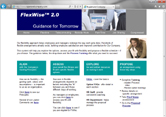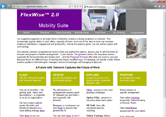|
Why a Focus on Talent, Mobility and
Productivity? |
|
 |
|

|
|

|
|

|
|
| |
FlexWise™ 2.0
Advanced
Guidelines |
|
FlexWise™ 2.0
Talent
Focus |
|
FlexWise™ 2.0
Mobility Focus |
|
FlexWise™ 2.0
Productivity
Focus |
|
| |
Flexibility Trends
The new FlexWise™2.0 Guidelines offer state-of-the-art,
comprehensive navigation for managers and employees seeking
flexible work arrangements that serve the individual contributor
and the business. They contain modified elements of our original
sites, including: |
|
■
Diverse leadership endorsements
■
Prioritized guiding principles
■
Intensive proposal process guidance
■
Persuasive success stories
■
Implementation tips plus training on each option |
|
These thorough guidelines can help deliver the growing range of
flexibility outcomes – and deliver them well. They include: |
■ A
positive effect on recruitment
■ A
proven impact on retention
■ An
increase in employee engagement
■ The
retention of older workers
■
Savings in reduced office space
■
Improved client service and coverage
■ A
reduced carbon footprint
■ A
tool for business continuity |
|
While internal champions of flexibility have been slowly
expanding this list, many companies seem to be moving in a
different direction. They are focusing their efforts, seeking
one of three major outcomes.
Talent
As the use of flexibility has matured, the casual approach to
its recruitment and retention powers has given way to its
inclusion in Talent Management. The
need for the systematic is replacing the ad hoc as the value of
talent becomes increasingly evident.
Mobility
No flex trend has been more pronounced than the explosion of
mobility – telework and the space-saving, traffic reduction and
business continuity it enables. In many cases, even as companies
launch major new efforts, the growth is outstripping the
mobility supports.
Productivity
As companies continue the quest for greater productivity, many
are turning to flexibility as a possible source. One focus is on
more systematic ways to define, enhance and measure individual
outcomes. The shift from general claims to reliable productivity
is a high priority. |
|

|
FlexWise™ 2.0 Solutions
As company goals for flexibility initiatives become more
refined, there is great value in developing specialty guidelines
that support these efforts. All FlexWise™ 2.0 guidelines
start with the same basic capabilities and features, and add
elements such as these:
FlexWise™ 2.0 – Talent
A standard approach to flexibility enables the retention of the
talented and the hope of recruitment and engagement. The focus
on talent adds these distinct capabilities: |
•
a decision-making standard and form based on “no
harm”
•
support tools to strengthen manager decision-making
•
aggressive training to promote the retention power
of flex
•
a system to facilitate flex for new hires from Day
One
•
use of a work redesign toolkit to enhance flex and
satisfaction |
|
FlexWise™ 2.0 – Mobility
Hundreds of companies have turned to more mobile workplaces to
reduce space costs and achieve other goals. The primary
flex tools in use are referred to as telework. The mobility
focus adds: |
•
video-based training of managers, employees to
improve productivity
•
more intensive employee and manager skills
assessments
•
preparatory suites of webinars, online tools and
live training
•
package of goal-setting, evaluations and remedial
training
•
customized, intensive online implementation training |
|
FlexWise™ 2.0 – Productivity
Links between flexibility and productivity have been made
frequently but verified less often. Systemic improvements such
as group gains are more common than the productivity that grows
out of individual flexibility. The productivity focus includes: |
•
detailed assessments and aptitude scans for
results-orientation
•
a video-assisted, high-impact proposal process
•
apply standard and use proposal form that seek
“positive business impact”
•
a guide and tools for refining metrics and
evaluating performance
•
application of a customized work redesign toolkit |
|